Saturday, December 30, 2006
Peoria Pundit Posts
Please go to Peoria Pundit posts. The majority of these posts concern the abandonment of Haitian Hearts children by the large Catholic medical center in Peoria.
Maxime's Host Parents

The Peoria Journal Star published a forum article today written by Maxime's host parents when he was a patient several years ago at OSF.
The letter asks the question: how should OSF's disagreement with one doctor influence their policy when lives of Haitian children are at stake? OSF's attorney talks about cooperation and respect. Who do they think is going to believe this?
If what I challenged OSF on was not reasonable they would not have responded so negligently towards the Haitian Hearts patients.
I have questioned them on lack of bed capacity, long waiting times in the ER, monopolizing ambulance care in the city of Peoria, delaying Haitian kids surgeries, attempting to obtain funds for Haitian Hearts that were not meant for OSF, and showing total lack of respect for their own Mission Statements and the Ethical and Religious Directives for Catholic Health Care Services written by the U.S. Catholic Bishops.
Saturday, December 23, 2006
Peoria Pundit

The Peoria Pundit" has been kind enough to allow me to post on his web log.
This week we were able to get Maxime on the plane for Cleveland where he safely arrived yesterday.
Yesterday was another bad day for Haiti. Four hundred special UN troops and Haitian National Police entered a portion of the slum called Bwa Neuf. They had been given the clearance by the Haitian government to make the sweep and were unsuccessfull killing the gang leader they went in to kill. However, nine civilians were killed and 30 others were injured in the raid. I have been in the area many times and the thought of what happened yesterday is very scary.
The people of the slum are very unhappy with the UN.
Monday, December 18, 2006
You Would Think They Were Human

Jackson Jean-Baptiste's sisters are pictured here.
Jackson was refused care at OSF-SFMC in Peoria last year. Jackson died in January of this year and is buried in Illinois, close to Peoria.
At Jackson's funeral in January, over one thousand dollars was donated by people in central Illinois that knew Jackson or had heard about his struggles. This money was for his mother that lives with his two sisters in a small cinderblock house in the mountains overlooking Port-au-Prince.
Jackson's mother still cries frequently when she thinks about him and how sick he was last December. She misses him.
Maxime

Maxime is the 21 year old Haitian young man who was rejected by OSF-SFMC in Peoria for repeat heart surgery. He sleeps kneeling on the floor with his upper body draped over the bed. He can breathe better at night in this position but still sleeps fitfully. He shouldn't have to exist like this.
Maxime has been accepted by Cleveland Clinic Foundation for evaluation. We are trying to keep him alive in Haiti until we get him to Cleveland.
When I told Maxime's brother this morning that he had done a good job taking care of Maxime, he smiled and responded in Haitian Kreyol, "We want life".
OSF Attorney Responds to Haitian Hearts

Please see Peoria Pundit. OSF attorney, Douglass Marshall, sent me an e mail regarding OSF's refusal to accept any Haitian Hearts patient.
Ferna, the baby in the picture above, died with a cardiac defect (ventricular septal defect) that could easily have been repaired by the skilled physicians at OSF.
Saturday, December 16, 2006
Friday, December 15, 2006
Cleveland Clinic Rescues Peoria's OSF
Go to Peoria Pundit to read encouraging news for Maxime Petion.
Thursday, December 14, 2006
Kidnapped
 On Tuesday my wife and I looked up when we heard the low rumbling chop-chop sound and saw a white UN helicopter circling over one of the major slums in Port-au-Prince. The pilot continued this maneuver for an hour. Obviously he was looking for activity on the ground. We now know what he was searching for.
On Tuesday my wife and I looked up when we heard the low rumbling chop-chop sound and saw a white UN helicopter circling over one of the major slums in Port-au-Prince. The pilot continued this maneuver for an hour. Obviously he was looking for activity on the ground. We now know what he was searching for.There has been a string of new child abductions in Port-au-Prince. Gunmen abducted at least 10 children in and around Port-au-Prince this week. Approximately 100 adults and children have been kidnapped in November, and another 60 already in December.
What has everyone’s attention in Haiti is that children are now being targeted. Many of the kids are released unharmed, but a six year old boy was recently abducted in the capital and taken to a large northern city and shot.
“Snatch teams” work in the city. They abduct adults by boxing in their vehicle in traffic and heavily armed thugs grab them. The victims are then transported to one of the local slums where gangs move the abducted around and make ransom phone calls from the ubiquitous cell phones which many people carry. Sometimes the abducted person is moved to another gang. Unless you live in the slum or are a gang member, no one can enter the slum safely, including the 9,000 UN soldiers in Haiti.
This week, at several schools in the capital, men would show up after school was let out saying they were the child’s guardian and that they were there to walk the child home. They have shown false ID’s and stolen the child. In an incident that made international news, a vehicle with seven children on board was hijacked by armed thugs just north of Port-au-Prince, and the kids taken. (All the children were released unharmed several days later.)
Several days ago a spokesman for the United Nations police force in Haiti said, “Now the kidnappers target children because they know the children are our hearts. They want to hit us in the heart so they can get the money more rapidly.”
The residents of the capital are even helping police in door-to-door searches for the missing children. Fear of kidnapping has led many schools in the capital to close until after the Christmas holidays. The number of children in their school uniforms, laughing and talking with each other while they walk down the sidewalk to or from school, has decreased.
Haiti’s infant mortality rate is one of the highest in the world, most Haitian kids do not get enough to eat, suffer parasites, lack primary medical care, and carry heavy loads of water on their heads. When you think that Haiti’s children could not suffer any more injustice, you find out that you were wrong.
They start kidnapping them.
Elephantiasis in Haiti


When I got off the full tap-tap this morning in front of the hospital, many people were crossing the street, buying and selling things on the corner, and a couple of men were fixing flat tires. Children were also heading to school in their fresh uniforms.
At the very back of the tap-tap, standing in the street, was a 60 year old appearing man who had dropped his pants in a very innocent fashion to show all of the people in the vicinity his huge scrotum that was hanging down in front of him. His face was pathetic as he was searching everyone’s eyes. He was looking for some spare change so he could eat or “find” medication. He was filthy. People stared at him, but did not laugh, and then turned back to what they were doing or headed on their way. No one offered him anything.
This man’s serious problem is called filariasis and is caused by a parasite spread by mosquitoes. The parasite has different stages and causes the lymphatic system to become blocked. Severe swelling can occur in dependent areas of the body. When the anatomy becomes very swollen and distorted the condition is called elephantiasis.
There are 120 million cases of filariasis world wide with at least 40 million having severe deformities as did the poor man in the street. Haiti has its fair share of elephantiasis.
The lady pictured above has a severe case of elephantiasis also. She is a clinic patient in Cite Soleil. She has had this swollen right leg for over 25 years. Medication will not help her now other than to treat bacterial or fungal infections that may superinfect her damaged extremity. Can you imagine limping around fetid Soleil with a right leg like this?
Below is a water canal in the middle of Soleil that dumps directly into the Bay of Port-au-Prince. It breeds mosquitoes which will carry the parasite and will make the lives of others as miserable as hers and the man behind the tap tap.

Tuesday, December 12, 2006
Water in Haiti

Haiti’s trees have been cut down. We all know that. The poor farmers cut down the trees because they needed to turn them into charcoal in underground stoves. They need a fuel source and need to sell the charcoal for money.
Now since there are very few trees on the mountain sides, and when the rains come hard, the topsoil is carried away. Since the trees and topsoil are gone, the rainwater is not sufficiently absorbed into the underground water source called the aquifer.
The Port-au-Prince aquifer is ever shrinking and with a lack of pressure in the underground water source, salt water is leaking in. Thus, there is not near enough clean from the 18 springs that supply water for the three million people in the capital.
In fact, greater than 60% of eight million Haitians do not have access to clean water. Haiti ranked last on the International Water Poverty Index.
Haitian kids as young as four years old carry water in plastic containers. Children walk many miles in the countryside and the cities to bring water back home for the family.
Poverty has caused Haiti’s ecologic suicide which has contaminated Haiti’s water. And the bad water is killing Haiti's babies.
Haitians Are Afraid

Everyone is scared.
Everyone is fair game to be taken. Haitians with means are leaving the country.
Mothers have no money for food for their children. They have no money for a simple doctor visit. They are afraid to go on the streets with their children.
Parents are afraid to send their children to school. One did yesterday and the child did not come back.
Hospitals do not have adequate medications or bed capacity. Doctors working for the State of Haiti are not paid and go on strike frequently.
The psychiatric hospital in Port-au-Prince is full.
A Haitian policeman told me today that when people don't "put their heads together" and work out problems, "they can act like savages". He then asked me to buy him a car.
Only a few people on both sides of the Haitian economy are paralyzing this country.
People are running to get out of the capital. People are trying to leave the country.
Everyone is scared.
Monday, December 11, 2006
The Face of Aids In Haiti

Go to Live From Haiti to see the face of AIDS in Haiti.
Supposedly eight million people live in Haiti. Four million are under 14 years of age.
We are in the 25th year of the AIDS pandemic. Haiti has lost 400,000 people to AIDS during this time.
Experts see no end in site for children orphaned by AIDS. Also, one-fourth of children born to HIV/AIDS infected mothers are carriers themselves. Even though highly active antiretrovirals are advertised as available for kids in Haiti, they are harder to comeby than some would believe.
In the streets of Port-au-Prince one use to see mainly boys years ago darting in and out of traffic begging. Now there are many girls begging for money for themselves and their families.
Orphanages are filled to capacity with beautiful children with hollow looks on their faces. They need to be held.
Monday, December 04, 2006
Open Letter to The Catholic Diocese of Peoria and OSF

December 3, 2006
Dear Bishop Jenky, Sister Judith Ann, Keith Steffen, and Paul Kramer,
I have been following the weather conditions in Peoria from here in Haiti. The snowfall, winds, and cold seem to have partially paralyzed central Illinois.
Haiti’s condition is actually much worse than Peoria, even though the weather is much nicer. The people here suffer every sort of injustice known…except snow and ice.
Please prayerfully consider accepting Maxime Petion at OSF for evaluation of his heart. I e mailed you about Maxime 6 weeks ago, but didn’t hear back.
Maxime was operated several years ago at OSF when he was 17 years old. He is suffering greatly in congestive heart failure.
It is my understanding that OSF’s International Committee is going to meet this week and discuss whether Maxime will be accepted at OSF. Unfortunately, no Sisters sit on this Committee.
As you know, Paul Kramer, Director of Children’s Hospital of Illinois, called the American Consulate in Port-au-Prince several years ago to stop Haitian Hearts patients from obtaining visas to travel to Peoria. Mr. Kramer sits on the Committee. Also, OSF’s legal counsel, Doug Marshall, wrote me a while back stating that OSF will not accept any Haitian Hearts patients even when full or partial charges were offered. These actions by OSF’s leaders are opposite to the Sisters Mission Statements and the Ethical and Religious Directives for Catholic Health Care Services written by the Catholic Bishops in the United States.
His host family in the Peoria area are very concerned about Maxime and even suggested to me that they come here to be with Maxime and his family. Political violence and kidnappings in Haiti are at an all time high, so I have discouraged his host family from traveling here.
Haitian Hearts will offer you $10,000 up front for Maxime’s life. I am pleading with you to give Maxime another chance at OSF.
He will die soon unless something is done very quickly.
Sincerely,
John
Sunday, December 03, 2006
Structural Violence
 I remember the first time I read about “structural violence” regarding the poor in developing countries. I did not understand what the author was writing about. Medical students don’t take courses in structural violence. We may know about the Sylvian fissure, the coronary sinus, and oncotic pressures, but structural violence was definitely not mentioned in my training. Until I came to Haiti.
I remember the first time I read about “structural violence” regarding the poor in developing countries. I did not understand what the author was writing about. Medical students don’t take courses in structural violence. We may know about the Sylvian fissure, the coronary sinus, and oncotic pressures, but structural violence was definitely not mentioned in my training. Until I came to Haiti. Farmer, Nizeye, Stulac, and Keshavhee wrote a great paper called “Structural Violence and Clinical Medicine”. The bottom line is that until doctors understand structural violence and do something to change it, all of the molecular biology and genetics in the world will not significantly help the world’s poor.
The authors define structural violence as…” social structures—economic, political, legal, religious, and cultural—that stop individuals, groups, and societies from reaching their full potential. In its general usage, the word violence often conveys a physical image; however according to Galtung it is the “avoidable impairment of fundamental human needs or…the impairment of human life, which lowers the actual degree to which someone is able to meet their needs below that which would otherwise be possible.”
Structural violence is often embedded in long standing “ubiquitous social structures, normalized by stable institutions and regular experience.” Because they seem so ordinary in our ways of understanding the world, they appear almost invisible. Disparate access to resources, political power, education, health care, and legal standing are just a few examples. The idea of structural violence is linked very closely to social injustice and the social machinery of oppression”.
Farmer goes on to say that, “With few exceptions, clinicians are not trained to understand such social forces, nor are we trained to alter them. Yet it has long been clear that many medical and public health interventions will fail if we are unable to understand the social determinants of disease.”
Anyone with a third grade education should be able to understand this. Structural violence as a concept is not hard to understand. But it is a scary concept to people that have because those of us who have do not want to lose any of it.
Haitian Hearts brings children from Haiti to the United States for heart surgery. That is challenging to many people with Haitian kids invading their neighborhood and medical center. The same people that are challenged seeing these kids in their community would be fine with the concept of throwing some money at them in Haiti to put them in school or give them some rice and beans each day.
The child pictured at the top has very aggressive tuberculosis. The social structures in the world did not allow this child to “reach his full potential”, i.e. good health. This child definitely had “disparate access to resources…”
The picture at the bottom is a photo of a crushed empty bottle of Pedialyte lying in a puddle of sewage on a major street in Port-au-Prince.
Thanks to Haiti, even I can understand the danger and damage and death created by “structural violence” in the world.

Saturday, December 02, 2006
Ground Zero Haitian Blogs
 This little girl is from LaSaline, one of Haiti's infamous slums. She lives near the wharf where the sea containers are stored.
This little girl is from LaSaline, one of Haiti's infamous slums. She lives near the wharf where the sea containers are stored. To see how a large Catholic medical center and Catholic Diocese in the midwest are neglecting Haitian children that desperately need heart surgery, go to Peoria's Medical Mafia. Also, go to Live From Haiti to see what is happening in Port-au-Prince from ground zero.
Thursday, November 30, 2006
Pigs and Puddles
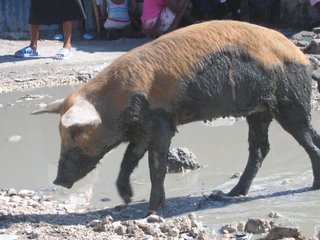
This pig and puddle are right outside the front door of our medical clinic in Cite Soleil.
No wonder the patients waiting for us everyday have typhoid fever, diarrhea, malaria, dengue fever, and a host of other water borne illnesses. Hundreds of thousands of people in Haiti's slums have no clean water for themselves or for their children.
As Aristide and Farmer would say, "This is indecent poverty".
Should the baby you see below, examined in the clinic a few feet away from the fetid water and pig, be part of this indecency?
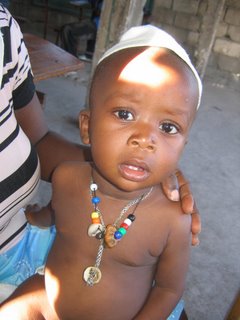
"To designate a hell is not, of course, to tell us anything about how to extract people from that hell, how to moderate hell's flames. Still, it seems a good in itself to acknowledge, to have enlarged, ones's sense of how much suffering is caused by human wickedness there is in the world to share with others."
Susan Sontag
(Taken from Paul Farmer's lecture at University of Utah, March 30, 2005)
Mirlande
 Mirlande is 14 years old. She lives in the central plateau of Haiti in the Artibonite about two hours north of Port-au-Prince. It is a fertile valley with rich black dirt and adequate rainfall. Rice,sugar cane,and tropical fruits are abundant.
Mirlande is 14 years old. She lives in the central plateau of Haiti in the Artibonite about two hours north of Port-au-Prince. It is a fertile valley with rich black dirt and adequate rainfall. Rice,sugar cane,and tropical fruits are abundant. Mirlande has valvular heart disease due to rheumatic fever. She needs her mitral valve repaired or replaced. She cannot walk far due to her heart failure.
I have her on multiple medications to decrease the stress on her heart.
She needs heart surgery very soon in the United States or her days in the beautiful Artibonite Valley are numbered.
Chimere
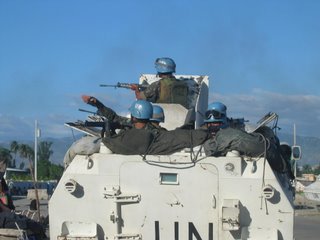 Rounds of automatic gunfire will definitely cause guys to jump off the open window sills in the clinic. This happened yesterday. As things became quiet, they would wander back over to the windows and timidly look out onto the street. Women vendors could be seen running. However, inside the clinic the patients barely flinched.
Rounds of automatic gunfire will definitely cause guys to jump off the open window sills in the clinic. This happened yesterday. As things became quiet, they would wander back over to the windows and timidly look out onto the street. Women vendors could be seen running. However, inside the clinic the patients barely flinched. One can hear about the United Nations and the gangs warring in Soleil, but to be in the slum, working the medical clinic, with the gunshots so close is the real thing.
The variety of patients were the same as usual in the slum. After checking about 100 patients, treating them, and giving them the best disposition we could under the circumstances, we left Soleil in our ugly white “mobile medical van”. It has two huge home made flags with pineapples painted on them. Coursing through the narrow streets we could hear rounds of gunshots again from an unknown location.
We followed a UN tank of soldiers pictured in the photo above. Their faces appeared very tense. I didn’t know if it was good or bad that we were so close to the tank. Were the gunshots headed for them? If we followed too closely would the soldier who had his rifle aimed at our windshield shoot? Did they know we were “friendly”?
The UN tank in front of us turned to the left and we continued straight ahead to take a different way out of Soleil. A few hundred yards down the street were UN tanks that were parked to the right of us. As our driver laughed, some of us sank low in our seats just in case because the soldiers were obviously edgy and their arms were aimed right at our vehicle. Our Haitian doctor wisely summarized the situation and said, “You never know.”
We made it out of the slum just fine. But most of our patients did not nor did their 200,000 neighbors that live there. They are caught every day between poverty and bullets.
The young man pictured below was shot by UN forces and underwent a right leg amputation. His brother, who looks like he is a twin, was shot in the left leg by UN forces also and has a lower leg fracture that never united so his left foot just hangs at the bottom of his leg. The brothers both have crutches and forearms with tatoos.
I asked them why the UN comes into Soleil and shoots. Their answer was that the UN does not like young people in dread locks who are “dragons” (chimere).
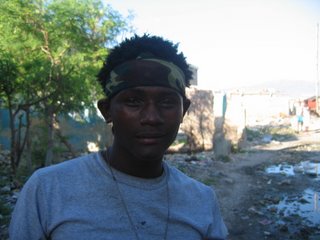
Sunday, November 26, 2006
Angel and Stanley
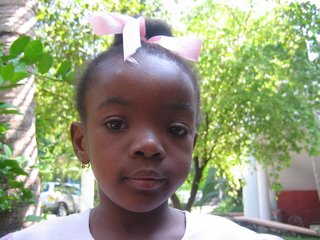
Angel is five years old and is pictured at the top of this post. Stanley is 13 years old and pictured at the bottom.
I examined Angel in Haiti several weeks ago. Her heart revealed an ominous sounding murmur. Her echocardiogram shows complex congenital heart disease.
I examined Stanley today. He was in the back seat of a car and had to be carried to a wall that he sat on while I examined him. His mother and father are dead and he lives with his aunt here in Port-au-Prince. He put his head on her shoulder as she stood by him supporting him.
Stanley can only sleep in a sitting position because he is in congestive heart failure and is drowning. His heart valves sound very ill on exam. Stanley’s abdomen and legs are intensely swollen with fluid. The inside of his eyelids are white indicating anemia.
Angel needs no medication at present but I gave Stanley digoxin, furosemide, and potassium, antibiotics, and iron supplement.
Both Angel and Stanley need heart surgery to stay alive.
They are numbers 34 and 35 on the Haitian Hearts list of children destined to die as we look the other way.

Clinics, Kidnappings, and The Baron

The following is an account of two trips with a mobile medical team in Port-au-Prince. I can’t mention the names of anyone, because, as the Haitians say, things are “hot” in Haiti.
Father and his mobile medical team picked me up in the morning. The plan was to work in two slums in Port-au-Prince. There were about six Haitian guys on his medical team in the vehicle. Father told me that he needed to pick up the body of an old man that died and give it a proper burial before we headed for the slum and the clinics. Another missionary had notified Father of his death the day before.
Our driver drove us down to airport road and we headed across Route National 1. The cemetery was on one corner and UN tanks on the other. We headed a few feet down the Route National 1 and then took a hard left down a dirt road for two miles. I hadn’t been on this road for over one year. There was no traffic due to the kidnappings and carjackings over the last several years. The soccer fields were empty.
At the end of the dirt road we turned right onto notorious Route 9 which leads directly out of the slum. We headed north into the countryside for several miles.
The sugar cane fields looked really healthy to the east. Passing over a bridge revealed ladies down on the edge of the little brown river washing their clothes.
The missionary bringing the body was not at the second bridge as was planned and so Father called him with his cell phone. He said he was just several minutes away. A small crowd of people stopped on the edge of the road to see what we were doing. A man selling popcorn wrapped in cellophane bags came along and sold us about 10 bags that everyone seemed to dive into like we were at a movie.
Father proudly showed us his cardboard coffin he had made for the newly deceased man. It was in the shape of a coffin and looked quite impressive as we laid it on the highway behind our truck. Father remarked how the coffins in the future will have a coat of brown varnish on them as well as a symbol of his order. As we munched the popcorn, we all stared approvingly at the coffin.
Father takes the dead quite seriously in Haiti and he does all he can to give them a proper burial. He believes this is the highest form of charity. Father receives calls like this all of the time and has purchased some spots in the cemetery that we passed to bury the remains. If he did not, the families of the deceased have no money for a proper burial, and the bodies go from a general morgue to a field where pigs eat them and they rot in the sun.
As promised, a white van came from the north with a white man driving. A Haitian man was in the front passenger seat. The white man had a nice peaceful smile as he opened the back of the van. Lying on a green Styrofoam cushion was the body that needed a proper burial. It was covered with a white sheet. The deceased’s left elbow was sticking out just a little.
The popcorn was put down, and we carefully lowered the body into the cardboard coffin and slipped the lid back on. Father said about 5 minutes of prayer in Creole including the Our Father and a song as we stared down at the coffin on the highway. Everything was done with respect as the people on the side of the road watched. We then lifted the coffin into the back of our truck, some guys climbed in beside it, and the rest sat up front in the two cabs. We turned around in the middle of the road and went zooming back into Port-au-Prince.
Upon arriving back at the cemetery in the city, the graveyard man seemed happy to see us. He looked like he was about 80 years old, had a very distinguished face, with a full head of gray, straight hair.
We scooted the coffin out of the medical van and carried it to a vault that had the side panel removed by two men. Peering down into the hole that would be the body’s resting place forever revealed a drop off of several feet. Another couple of prayers were said by Father and we slid the casket down into the dark hole and it landed with a clunk.
We walked several yards away where there is a “Baron’s Cross” to honor Baron Samdi who is chief of the Gede Spirits. These spirits are responsible for the dead, cemeteries, and procreation. Believers honor the Gede as well as their dead relatives in the cemetery.
At the foot of Baron’s cross, which was made out of stone, were burned human bones. I could identify femurs and humerii. A small empty bottle of rum was on the ground and a Haitian coin and two Gillette razors were carefully placed on one of the arms of the Baron’s cross.
After leaving the cemetery, we piled back into the mobile medical van, passed some white UN tanks, and headed for La Saline. We stopped once on the way and purchased some small bags of water to have clean water to mix with the powdered antibiotics for the babies.
La Saline is another slum on the ocean front. There are four main slums in Port-au-Prince with an 8 square mile area. These slums are homes to hundreds of thousands of unfortunate people.
I have been coming to Haiti for 25 years and La Saline was the worst area I have seen. I won’t try and describe the garbage, sewage, heat, people, and traffic as we inched our way through the slum. No written words do it real justice.
We headed to Waf Jeremy (Jeremy’s Wharf), a pathetic zone inside of Saline. It sits right on the brown colored Port-au-Prince Bay which flows in from the Caribbean. Because we couldn’t move in the traffic, we got out and carried the picnic sized coolers filled with medication to the shanty Father uses as a clinic. The streets were black puddles and mud with pigs, people, and men pulling incredible loads on carts.
Upon arriving in the clinic, which had a dirt floor and corrugated metal walls, we found a 12 year old girl lying on an old green army cot surrounded by many of the patients. She had an IV hung with solution dripping in. Father said a quick prayer for her and for a successful clinic day and we started. I walked around the clinic and picked out the five sickest adults and babies and they were drug and carried out to Father’s vehicle where they were transported to another clinic in the city where they could be admitted and given “more comprehensive care”. Two adults acted confused as if they had typhoid fever from the fetid water in La Saline.
I was assigned an “office” in the corner. It had a chair and a small table for me to write. The patients chair legs were stuck in the hard black mud and was not moveable. Adults and children would file in over the morning with hernias, abscesses, hypertension, heart failure, and malnutrition.
The clinic pharmacy was set up a few feet away from me where we could treat some of the basic tropical diseases that we encountered. We also had a point-of-care lab tests which included HIV. Patients were given rendez-vous for the following week depending on their illness and need for follow up.
Behind the steel wall a few feet away was a classroom which shared the same wall as our clinic. Children that were neatly dressed in red and white uniforms and appeared to be kindergarten were in the classroom. There were no chalkboards, books, pencils,
papers, crayons, or anything academic that I could see. The teacher sat at the door talking on her cell phone.
When clinic was almost over, I heard gunshots in the distance. It was hard to tell exactly where they originated. Our vehicle came back for us and we walked about a one quarter mile through the narrow paths by women doing their laundry in large plastic bowels in the mud and kids in uniform leaving school for the day. People in the neighborhood waved good by to us. Some of our patients were walking with us. They were glad to be getting home because of the gunshots.
We left for Cite Soleil for our second clinic. Turning off of the main street into Soleil revealed four UN tanks with blue helmets seen barely poking out of the top. Two Jordanian UN troops were killed several weeks ago in a skirmish with one of the gangs in Soleil.
The roads in Soleil were cleaner than in La Saline but some were completely blocked with large rocks to keep the UN forces out. Clinic was held in a two story house made of cinderblock. There was no electricity and no running water. The ground floor was packed dirt. The upstairs floor was cement. It was nice and cool in the building—there were no windows and a breeze came through large spaces in the cinderblock. I checked pediatric patients downstairs and adults upstairs.
The Soleil children are usually accompanied by their mother and most were babies. I worked in a room that was dark and so I sat by the door to get as much light as I could to examine them and write a brief medical note.
The babies and children were malnourished and many had fever. They were very docile and made little eye contact. The mothers were appreciative of anything we attempted to do for their children. They picked up their children’s medication in a room near the front door.
Upstairs the adults had the same complaints as most poor Haitians. However, some were just very stressed living in Soleil with the constant warfare between the gangs and the UN forces. The cinderblock wall behind my table had four bullet holes from the UN’s powerful weapons.
After we had been working about an hour, a local gang leader with dreadlocks ascended the steps with his machine gun slung over his shoulder. He was just seeing how things were going and quietly talked with Father for awhile and left.
Clinic mercifully ended about 3:30 PM and we packed and left. However, Father had been sent a message that another more important gang leader wanted to see him before we left Soleil.
We stopped in his neighborhood and Father visited him for about 40 minutes. The gang leader there is considered the most vicious of the five leaders in Cite Soleil. He had a big smile but his eyes were very cold. Murals were painted on the wall of the Sacred Heart of Jesus and another wall had a brightly painted machine gun. A Che Guervera flag flew in the breeze over the cement compound. Young men walked close by with their 45’s in their right front pocket. If I hadn’t seen the guns, it just looked like a cleaner neighborhood in Soleil. After the meeting was over, we left for home.
Father has a good relationship with all of the gang leaders which has allowed him to negotiate for the release of 60 people ransomed and held in Cite Soleil during the last year.
The kidnapping in Haiti is higher than any other country in the western hemisphere. Port-au-Prince is particularly dangerous. People are taken in the street, many in the middle of the day, and delivered to a particular gang in the slum. Calls are made to the captive’s family and prices discussed. With Father’s influence, the ransom is brought to another gang leader and the taken person is hopefully safely transferred as is the money. The kidnapping gang trust the other gang leaders and hope they will avoid a sting by having the other gang involved. The ransom money is used to buy more bullets and rum.

Friday, November 24, 2006
Luke's Flower

Marie-Rose appeared to be about 40 years old. The nurses said that she is the mother of ten children. She had no family members present. When I was called in to check her she was propped up in bed and not responsive. Her eyes were closed and her breathing was fast. The systolic blood pressure was 50 mm Hg in her right arm. Her dossier showed that she had metastatic gastric cancer. I turned her IV to a keep-vein-open rate. Someone placed an oxygen mask on her face.
The nurses and another doctor stood at her bedside and prayed for her. After the prayer, amazingly Marie-Rose opened her eyes and said to everyone, “Thank you for praying for me.” She closed her eyes and the doctor told her not to resist and to go to the next world. A few minutes later she passed away comfortably without efforts to keep her with us.
Shortly after, two men carried a well-worn stretcher up the steps and she was placed in our little morgue. Flowers were placed on the white sheet that covered her body.
The doctor that had prayed at Marie-Rose’s bed told me to place a white flower from the garden on her body. She said that Marie-Rose could now intercede directly for our son Luke and our intentions.
We both knew that Marie-Rose will not resist our requests and we know she appreciated Luke’s flower.
Thursday, November 23, 2006
A Look of Concern

We had clinic yesterday in Cite Soleil.
One patient was a 49 year old man. He had a 6 foot pole which served as his walking stick. He was wobbly when he walked and had a look on his face that he is dying. Beside him was a smiling seven year old son who accompanied him to the clinic in the slum.
They are homeless in one of the worst places on earth and live on the street.
The father said his hip hurts and he has no money for food or school for his boy. He is skin and bones and his face would contort from a worried look to a confused look as he gave his history. He may have HIV and a recurrence of his tuberculosis that was inadequately treated.
Other clinic patients told me that the UN had entered the slum several days ago and shot at the houses. I don’t know why. There were at least four large bullet holes in the cinderblock wall several feet behind me in the clinic.
When we left the clinic yesterday afternoon I saw three white UN tanks entering the area. The UN soldiers had their automatic weapons ready and aimed at us as we passed them in our medical vehicle on the street. The narrow roads, some of them which are blocked with large piles of stones, try to keep the UN soldiers out. However, last night after the sun had set, I heard loud thunder-like explosions coming from the area of the slum and wondered about the look on the sick father’s face was as he and his son huddled in the street in the dark.

Saturday, November 18, 2006
OSF's International Patient Committee
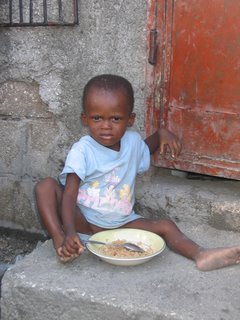
OSF-Children's Hospital of Illinois has an International Patient Committee. This Committee was organized to screen children from overseas to see who will be accepted by Children's. Paul Kramer, Executive Director of Children's Hosptial, and Joe Piccione, OSF Corporate Ethicist, are 2 members of the Committee. Interestingly, no Sister at OSF and no Catholic priest from the Pastoral Care department is on the International Committee.
Mr. Kramer and Mr. Piccione played big roles directly or indirectly in ending Haitian Hearts at OSF several years ago. Mr. Kramer slowed surgery on a Haitian child that needed surgery.
Doug Marshall, OSF attorney, notified me that OSF will not accept any further Haitian Hearts patients. How can this Committee look at the Haitian Hearts patients who were operated at OSF in Peoria 5 years ago with an objective eye? They can't and at least 6 former patients need to return or they will die like Jackson Jean-Baptiste did.
A biased Committee such as this puts the entire Mission of the Sisters in jeopardy.
Please see forum article in todays Peoria Journal Star.
Monday, November 06, 2006
Three Strikes

This shy little girl is eight years old. She was living at a home for sick, dying, and homeless adults in Port-au-Prince. Her mother has no money and could not care for her because she was sick all of the time with a constant cough and short of breath. She had also lost a lot of weight.
Her exam revealed a “wash machine” type of murmur that was very loud high on her chest. She had wet sounds in her lung as well and appeared very ill.
An echocardiogram had already been ordered by another physician which showed this little girl had a connection between her aorta and her lungs (patent ductus arteriosus) which allowed too much blood to flow through her lungs with each heart beat. This caused her heart to go into failure because the heart was receiving too much blood from the lungs.
Her chest x-ray showed pneumonia which is not uncommon in children that have too much blood shunted to their lung fields. However her pneumonia is tuberculosis.
Thanks to an American missionary who works in Haiti much of the year, a hospital in the United States accepted this girl to close the abnormal connection between her aorta and lungs. We started tuberculosis treatment in Haiti two months ago and continued her on her heart failure medication. She has gained weight and feels much better.
Haiti, heart failure, and tuberculosis are three strikes against her. However, thanks to the intervention of multiple people, she has a good chance now at long term survival.
Haitian Death Squads
Several years ago, while checking kids in the pediatric ward at the General Hospital in Port-au-Prince, I examined a 13 year old girl who I will call Stephanie. She had the cachectic, docile, sick look characteristic of children who have been sick and neglected for quite some time. She appeared very pathetic. Her caring older sister at the side of her bed fed and bathed her and changed her sheets. She told me that Stephanie had a heart problem for an unknown period of time and this was her first hospitalization. Their mother was dead and they were living in a home for girls.
Her heart exam revealed a murmur consistent with a leaky mitral valve. She was in chronic congestive heart failure.
After several months, Haitian Hearts was able to get Stephanie to the States for heart surgery and she eventually did very well after a rocky post-operative course.
Her father told me that Stephanie’s mother had died on January 2, 1992 after suffering a severe beating from the Haitian military. Apparently, her mother was an “Aristide fanatic” according to the father. One day in late December, 1991 Stephanie’s father was returning to his neighborhood on the outskirts of PAP, and his neighbors warned him that five soldiers were in his house and he better leave the neighborhood immediately. Stephanie was 15 days old and she and her siblings had been taken out of the home by vigilant neighbors before the soldiers arrived.
When he returned to his home, he found Stephanie’s mother severely beaten by night sticks and the wooden stocks of the soldiers’ rifles. She was barely conscious. He told me her face, chest, and abdomen were “blue”.
He left the capital immediately and hid on the southern part of the island. (For the next three years he snuck into the capital to check his family.) His mother, Stephanie’s grandmother, took care of his severely beaten wife and took her to the General Hospital in Port-au-Prince where she remained for two weeks. Grandmother bought medicines for her off the street, but surgery could not be done because the hospital lacked the equipment and grandmother lacked the money to purchase it.
Stephanie’s mother was discharged to home where she died a few days later after coughing up “a lot of black blood”. Her father showed me pictures of his wife’s body lying in the casket in her wedding gown, her face still bruised and swollen. She looked like she was in her late 20’s. She and Stephanie look like they could be sisters.
So Stephanie grew up in this slum with untreated rheumatic fever without a mother and with a father on the run from the Haitian military. Her life has improved but Stephanie’s father still talks in a whisper and looks over his shoulder hoping the soldiers do not return.
Her heart exam revealed a murmur consistent with a leaky mitral valve. She was in chronic congestive heart failure.
After several months, Haitian Hearts was able to get Stephanie to the States for heart surgery and she eventually did very well after a rocky post-operative course.
Her father told me that Stephanie’s mother had died on January 2, 1992 after suffering a severe beating from the Haitian military. Apparently, her mother was an “Aristide fanatic” according to the father. One day in late December, 1991 Stephanie’s father was returning to his neighborhood on the outskirts of PAP, and his neighbors warned him that five soldiers were in his house and he better leave the neighborhood immediately. Stephanie was 15 days old and she and her siblings had been taken out of the home by vigilant neighbors before the soldiers arrived.
When he returned to his home, he found Stephanie’s mother severely beaten by night sticks and the wooden stocks of the soldiers’ rifles. She was barely conscious. He told me her face, chest, and abdomen were “blue”.
He left the capital immediately and hid on the southern part of the island. (For the next three years he snuck into the capital to check his family.) His mother, Stephanie’s grandmother, took care of his severely beaten wife and took her to the General Hospital in Port-au-Prince where she remained for two weeks. Grandmother bought medicines for her off the street, but surgery could not be done because the hospital lacked the equipment and grandmother lacked the money to purchase it.
Stephanie’s mother was discharged to home where she died a few days later after coughing up “a lot of black blood”. Her father showed me pictures of his wife’s body lying in the casket in her wedding gown, her face still bruised and swollen. She looked like she was in her late 20’s. She and Stephanie look like they could be sisters.
So Stephanie grew up in this slum with untreated rheumatic fever without a mother and with a father on the run from the Haitian military. Her life has improved but Stephanie’s father still talks in a whisper and looks over his shoulder hoping the soldiers do not return.
"He Had a Great Smile"
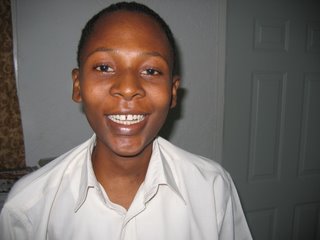
My wife always said that Dukens had a "great smile". He did.
I followed Dukens in Haiti for about one year. He had severe congestive heart failure due to rheumatic heart disease. He was very weak and could not attend school any longer. He had been a very good student. Dukens was 16 years old.
I was unable to get him accepted into a hospital in the United States for heart surgery to replace his tattered and incompetent valves.
Haitian Hearts treated him with medicine which helped just a little.
One day three weeks ago he told his mother that he was going to die. Fifteen minutes later Dukens and his "great smile" were gone.
Wednesday, November 01, 2006
Dangerous Infections
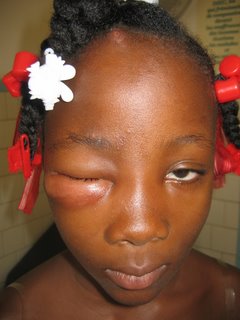
This 12 year old girl came into the clinic on a recent Friday. Her mother stated that she began to develop an abscess around her right eye two weeks prior. As the picture shows, her right eye was completely swollen shut. Her lymph nodes below her right jaw were enlarged as was the the lymph node in front of her right ear.
Her mother reported that she had a fever. The good news was that when I pried her eyelids open, her right eye moved freely in the socket which meant that she had periorbital cellulits rather than orbital cellulits which would be much more dangerous. Orbital cellulitis can spread to the brain very quickly.
I gave her a shot of ceftriaxone and put her on oral antibiotics and she returned on Monday. The picture below shows the swelling is much improved around her right eye.
It cost 75 cents to get in the clinic each day. That covered everything. This young lady was very fortunate that her mother was able to find the money. Infections like this can become very deadly when they are allowed to progress to this degree.
Poverty is the big killer in Haiti, but this time poverty lost.

Thursday, October 26, 2006
Maxime

Dear Doctors,
Maxime Petion is a 21 year old that was operated at OSF in 2002. He had a #27 CE pericardial valve put in his mitral position.
He has done well in Haiti until this year. He had a CVA on Oct. 5 which hit his speech center in his left cortex. He is much improved from a neuro standpoint. He talks and walks on his own. His strength is good in his right arm and leg 4/5. His speech is very good. Some motor aphasia but no receptive aphasia.
His exam today: 110/94 right arm. Bifid pulse at right brachial. Respiratory rate is 40 at rest. Able to lie flat without problem. Dyspnea on exertion but climbs steps well. Heart rate is regular about 80. Not in atrial fib. Neck--no JVD. Lungs diminished tones at right base. Chest xray in morning. Heart: 3/6 holosystolic murmur left sternal border about 6th ICS. PMI at 6th ICS midclavicular line. I think I hear a right sided S3. Could not hear a diastolic murmur.
Abdomen: liver not enlarged or tender. No ascites. No jaundice or icterus.
Echo today: Severe calcificed mitral stenosis with 31 mm gradient across mitral valve. Some MR. Moderate AI. Right ventricle and right atrium enlarged. Significant TR with RV pressure measured at 77 mm hg with PAP estimated at 87. Big left atrium. Normal size LV. LV has EF of 44%.
I have him on the usual stuff to try and keep him alive. Seems like mainly RV failure with high pulmonary pressures secondary to MS. No thrombus noted after stroke. I have him on ASA. No coumadin to give him now. He is alert and totally coherent. Good appetitie. My wife and I have him in our room with us.
I e mailed Sister Judith Ann and others several weeks ago about Maxime with no answer as usual. (Dr. McShane sent me an email a couple of months ago indicating he was blocking my e mails. So much for open and honest communication at OSF.)
Need your help. What should I do? Please ask Kramer and Steffen and Doug Marshall to come to their senses and accept these kids back that should not be denied care. (I know the Sisters have little say so.)
Thanks. His picture and quick video attached.
John
Monday, October 23, 2006
Mwen Swaf
 In Haitian creole "Mwen swaf" means "I am thirsty".
In Haitian creole "Mwen swaf" means "I am thirsty". The men that pull and push these huge loads are called mules. They usually have no shoes and walk with the traffic, exhaust, and mayhem in the street. The material they transport is frequently car parts and heavy metal. I have no idea how they do this.
Jesus was thirsty when he hung on the cross. The Haitians are thirsty for justice.

Sunday, October 22, 2006
Haitian Vaccinations
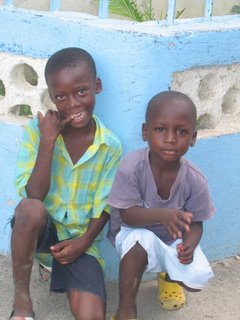
The national vaccine immunization program in the United States, directed principally at children, is one of the most successful examples of effective preventitive care. One of the most dramatic examples of the benefits of apporopriate immunization is the marked derease in cases of invasive Haemophilus influenzae type b infection since the introduction of this vaccine in 1987. Incredibly, the number of cases of children younger than five years of age in the United States declined by >99% by 2000.
Haitian children have access to standard vaccinations including diphtheria, tetanus, pertussis, measels, mumps, and rubella. They can also recieve oral polio vaccine and BCG vaccine (to prevent tuberculosis). However, very few Haitian children have access to "second generation" vaccines like Haemopilus influenzae described above. This bacteria can be particularly bad causing infections at multiple sites including meningitis and sepsis.
Other vaccines that only Haitian children with means have access to include hepatitis A and B, pneumococcus, influenza, meningococcus, and varicella-zoster(chicken pox).
All of these vaccines are considered "standard of care" for U.S. children that live only 90 minutes away from their Haitian neighbors.
Tuesday, October 17, 2006
The Wooden Bell

A couple of days ago, after clinic was over, I was eating with the sisters that run the clinic, malnutrition center, and school just outside of Port-au-Prince. Our talk concerned Haiti and its serious unending problems. The sister at the head of the table is from Spain and had been asked to leave Cite Soleil several months ago after gunfire between the United Nations and slum gangs blew big holes in the sister's convent wall as they were forced to lie on the floor to avoid the bullets.
In clinic, the babies with malnutrition and neglect have no real chance. Another difficult problem is babies that show up without a mother. This occurs frequently. The sister from Spain said, "When the Haitian mother dies, you may as well bury their baby at the same time." Unfortunately, this is not far from the truth. Aunts, grandmas,fathers,and neighbors usually are not good substitutes for the absent mother.
Today, the lady at the top of this post showed up where we are staying. Her name is Heureuse. Heureuse lives with Michael, her one year old boy, and her three year old daughter in a notorious slum on the edge of Port-au-Prince called Carrefour.
Heureuse had heart surgery at OSF in Peoria about 4 years ago and Haitian Hearts brings her medicine each trip that keeps her alive. We examine her and a recent echocardiogram here in Haiti shows that Heureuse needs to return for more valve surgery. OSF in Peoria will not accept Heureuse even though the doctors that took care of her several years ago would be glad to have her back and take care of Heureuse at no charge.
When Heureuse dies here, she will leave her two young children. She and her babies live with Michel's father. (The father of her daughter is dead.) Neither child is doing great now from a nutrition standpoint and when Heureuse is gone, both of her children will be at high risk for disease and death.
In todays (10/17/06) Peoria Journal Star there is a 20 page supplement that is entitled "Building a Medical Powerhouse". The articles report the 562 million dollars being spent in Peoria by the two major hospitals and the University of Illinois School of Medicine. They are all located approximately 4 blocks from each other. The local health-care community is lauded for taking the Peoria economy to "new heights" with the jobs and employment that the medical expansion creates.
OSF is building a new 8 story Children's Hospital as part of its 234 million dollar addition. Paul Kramer, Director of Children's Hospital, is quoted as saying that he wants a "world class" facility. However, it will never be "world class" when OSF and Mr. Kramer and other secular leaders dismiss the suffering of Heureuse and refuse to allow her to return to OSF for surgery. Mr. Kramer has his blinders on even though he knows the majority of the "world" live in the same "class" as Heureuse and her children. How can OSF be "world class" when they ignore the cry of the "global community" and focus on Peoria's economy.
New technology and research and jobs for any community are good. However, one obscenity lies in the difference in Peoria's half-billion dollar medical projects and Haiti's extreme poverty. The other obscenity is OSF's negligence of former patients that do not have technology, jobs, and research in their slum.
A Haitian proverb says, "No one hears the cry of the poor or the sound of a wooden bell". The good news for OSF is that Heureuse is "out of sight and out of mind". Her death will not be reported in Peoria and her children's struggles will never be known.
Peoria and its medical community are the losers when they deny health care to those who need it most. If OSF and its leaders really thought big, they would think of Heureuse and her children.
Dear Senator...

Dear Senator Raoul,
We hope that the benefit for GCH was very successful. My brother-in-laws and sister-in-law really enjoyed themselves on Saturday night and were very happy to meet you.
I have to give you a very grim medical report from Haiti. After 25 years of working in Haiti, I have never seen conditions so bad. The people here suffer so much from things that they shouldn’t even have like tuberculosis, malaria, and malnutrition.
Every day I have to force myself to walk to clinic and be part of this desperation. I can barely get in the front door of the pediatric clinic when I arrive because of the crowd that starts accumulating at 5 AM.
During the last year, we have brought a drug called ceftriaxone each trip to Haiti. It is a high powered antibiotic that can be given as a shot and will last for 12-24 hours before the baby needs a second shot. When I see a very sick infant, I give the shot quickly in the clinic. If there is no room at GCH or the baby does not meet the requirements for admission, I have the baby come back in the morning and admit it to GCH if there is a bed, or I take it to another hospital in PAP, and repeat the dose of ceftriaxone. If the baby survives this fiasco of medical care and the baby looks better, I convert the baby over to less expensive antibiotics that can be taken orally.
When I arrived at GCH clinic this morning, there had to be about 250 people crammed into the clinic (includes parents). My first patient was a 3 day old with a temperature of 102 F. I gave it a shot of ceftriaxone and sent the baby home with advice to mother to bring back tomorrow. The baby should have been admitted, but I couldn’t. Three day old babies with fevers are considered pediatric emergencies.
My next patient was a 16 day old baby boy who weighs four and one half pounds. His temperature was 102.5. His mother was very young and she had never given him breast milk, powdered milk, or anything other than water. His picture is attached and he is emblematic of Haiti. I baptized him with stagnant dirty water in a plastic bowl in my office. There was no running water in the clinic today.
I gave this pathetic baby a shot of ceftriaxone immediately and called a missionary who drove to the clinic, picked him up, and took him to another clinic/hospital where we admitted him. Sending him to the General Hospital is not a good option usually. (For one thing, his young mother had no idea where the General Hospital was in PAP!!)
The rest of my clinic day did not go much better. The acuity of disease here is horrible.
Over the years my wife and I have brought thousands of dollars of ceftriaxone specifically for patients at GCH. Since we are about out of this medication at this point, Maria’s parents purchased 300 more dollars worth of ceftriaxone in Peoria last week that I called in to our local pharmacy in Peoria, and sent to us by DHL. We followed the package’s progress via the internet. It arrived in PAP on Friday, but we received no call from DHL until this morning (Monday).
DHL is about one mile from here and they said that we owed them 5,473 gourdes for Haiti customs tax. This comes out to about $144 US. The entire package sent from Peoria has the ceftriaxone for many, many sick babies, and some germ-x soap, and some protein bars which totals about $350 US.
The Haitian government is asking us, to pay almost half of the cost of the package in customs taxes. The delivery by DHL was also very expensive and paid for generously by Maria’s parents. The ceftriaxone was also paid for by Haitian Hearts (Maria’s parents again).
DHL came this morning to deliver the package, but I refused to accept it or pay for it (the customs tax). This is absolutely outrageous. I explained that it contains medication for sick and dying babies, but no one seems to care. I am on my last couple of vials of ceftriaxone that we had from a previous trip and from this trip.
I don’t want to quit working at GCH but I strongly feel like terminating my work there until this problem can be addressed. It is just so difficult to have the medication ordered, purchased, and close by, but not available for the kids that need it most. This of course is not GCH fault or responsibility. Haitian Hearts pays for chest x-rays and medication everyday at GCH for patients who I see in the clinic, and know they have no money to pay for the x-rays and medications at GCH or anwhere else. We also admit them to other hospitals, and Haitian Hearts pays for these admissions also. I don’t want to quit working---I love what I do and who I work with, but if I have no ceftriaxone to take to the clinic, I will be baptizing the first 10 patients I see each morning. This work can feel very futile on a good day. It is just SO difficult as a physician to have my hands tied and not be able to do what is right for people that have no say so in their future.
Senator Raoul, will you get me a meeting with anyone you can think of that has influence at the level of national customs in Haiti. I would be glad to speak with President Preval or the Haitian Senate leader. A very powerful person needs to spend one day in the GCH clinic to see the problems at ground level. Someone needs to step up to the plate in the new Haitian administration. I need this medication now and Haitian Hearts will not pay for it again. We already paid for it in Peoria and sent it down here as fast as we could. The DHL truck drove away with it this morning….a very sad thing to see, especially if you are a sick Haitian baby.
Thank you very much for all you do.
Sincerely,
John
You may forward this e mail to anyone you think can resolve this problem.
Starving in Haiti
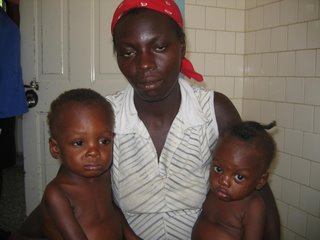
This mother, who was covered with sweat, brought her 3 year old in her right arm and 2 year old in her left arm to the clinic yesterday from a small village north of us. It cost 75 cents for each girl for the doctor visit and medication.
The 3 year old weighs 13 lbs. and the her 2 year old sister weighs 16 lbs. Both have fever, cough, and diarrhea. Both have no access to daily nutritious food, clean water, or medical care. Both are starving.
Peoria's major two hospitals are beginning 534 million dollar hospital expansions. The two hospitals are one block away from each other in a city of 113,000.
Tuberculosis and Cavities

The major site of infection of tuberculosis is the lungs. Tuberculosis causes the lymph nodes in the lung to enlarge, can appear like pneumonia, can cause extensive scarring, and even cause part of the lung to cave in and form cavities.
Cavitary lung disease from any cause is considered quite dangerours because of the destruction of lung tissue and also due to the fact that the cavities contain pus and bacteria.
When I listened to the lung of this little girl, I could hear hollow sounds over the cavity which are called amhoric, like the sounds made by blowing across the mouths of jars used in antiquity (amphora). When my stethescope moved slightly away from the cavity, the hollow sound disappeared. This is different than tubular breath tones heard in areas of consolidation like pneumonia without a cavity.
This girl would be considered infectious for tuberculosis because the cavity can contain more tuberculosis germs and she can spread them with a cough or just talking to someone. As a rule, children are not considered transmitters of tuberculosis. Identifying a pediatric tuberculosis case in the community means that there is an unidentified adult(s) that is/are spreading the disease.
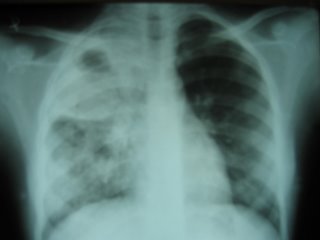
>
Monday, October 16, 2006
Alternative Medicine in Haiti

Alternative Medicine in Haiti
I saw this young lady in the clinic today. She is 23 years old and lives a few miles from the clinic but it takes her at least 30 minutes to get there down the dirt road leading to the clinic with huge holes, mud, and water.
She was very weak when she arrived and had to be pulled into the clinic. She was also very short of breath. Her blood pressure was 104/0. Her blood was drawn at our lab next door which revealed a hemoglobin of 3. She should have a hemoglobin of 14. She has very little blood cells circulating to carry oxygen to her cells. Her organs are starving for oxygen.
There are many causes of anemia in Haiti with iron deficiency at the top of the list. I don’t know if she has sickle cell anemia. She could have both.
She has no money to go to a public hospital and has no family member to take care of her in the hospital. So hospitalization in Haiti is not an option. She desperately needs a blood transfusion and we need to find the reason for her severe anemia. So I gave her a shot of intramuscular iron and some iron supplements to take orally. We also gave her a high protein drink and some corn curls as she sat in a chair with a smile on her face and devoured them.
I told her to come back to the clinic tomorrow for more injectable iron which is sometimes dangerous to give because of allergic reactions. But that is the best alternative for her now to quickly restore her iron. Haiti has given her no more “alternatives” than this. She smiled and said she would come back, but I realize now it is a national holiday. I had forgotten. I think she had too. Hopefully, she will return in two days.
I practice “alternative medicine” in Haiti and am very embarrassed.
Saturday, October 07, 2006
Haitian Fathers

Haitian fathers care about their children. They work as hard as they can to provide for their family. There is much work in Haiti but few jobs. And the jobs that do exist don't pay hardly anything. But Haitian men do work and can probably outwork anyone anywhere. I have seen them do incredible physical labor, such as clearing very heavy rocks from a huge field overlooking the Caribbean Sea, that I did not think was possible...and they did it with their bare hands.
This two year old girl, Chevalier, has a congenital heart defect known as a ventricular septal defect. It is a very common congenital heart problem which allows too much blood to flow back to the lungs through a little hole in the heart that shouldn't be there. After a few years, the heart can become enlarged and weak because it is receiving excessive blood. Also, the lungs can develop high blood pressure and refuse to receive blood from the heart which leads to death.
Chevalier has nothing irreversible right now. Her heart and lungs work well but she needs cardiac surgery now to close the hole in her heart. She will do well if she is operated before permanent damage is done.
Her father cares about her. She loves her father. He is depending on Haitian Hearts to find a hosptial in the United States to operate Chevalier.
Haitian fathers care. They work hard. They deserve much more.
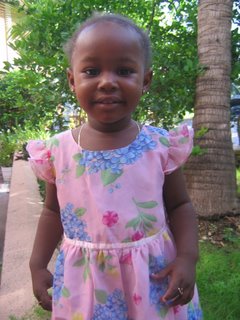
Subscribe to:
Posts (Atom)





